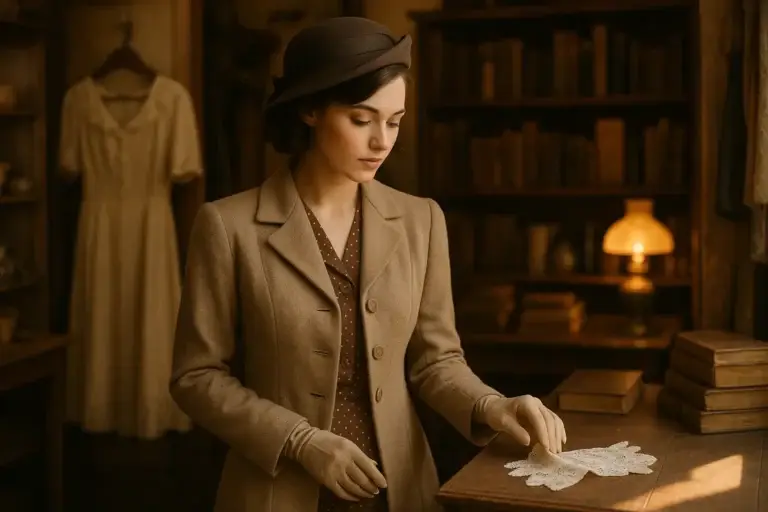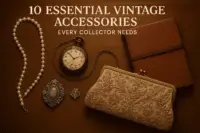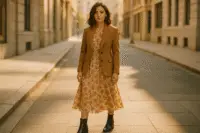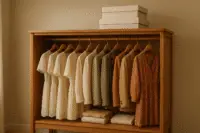Vintage fashion is a gateway to history. Each piece reflects the era it comes from, telling stories about societal norms, economic shifts, and personal lives. From 1920s flapper dresses to 1990s grunge outfits, vintage garments reveal how people lived, worked, and expressed themselves.
Key takeaways:
- Historical Insight: Clothing like 1940s wartime outfits or 1960s zoot suits highlight the challenges and attitudes of their times.
- Research Methods: Experts use garment analysis, oral histories, and digital archives to trace the history behind these clothes.
- Preserving Stories: Vintage fashion safeguards underrepresented histories, like the contributions of Black designers.
- Modern Relevance: Today, vintage is popular for its individuality, craftsmanship, and eco-conscious appeal.
Research Methods for Vintage Fashion History
Key Research Methods
Studying vintage fashion as a lens for historical storytelling involves several fascinating approaches that treat clothing as a primary source, brimming with cultural and personal significance. One method, archival analysis, dives into old periodicals, catalogs, and advertisements to uncover how fashion was marketed and understood within its social and historical context.
Another approach, often called “garment archaeology”, focuses on closely examining vintage pieces. By analyzing construction techniques, fabric choices, and signs of wear, researchers can piece together the garment’s history and even glean details about the lives of the people who wore them. Oral histories also play a critical role, capturing personal stories tied to specific garments, while digital documentation ensures these physical and contextual details are preserved for future study. Together, these methods transform vintage clothing into a vivid medium for understanding the past.
Material Culture and Personal Stories
Viewing vintage fashion through the lens of material culture connects the craftsmanship of clothing to the personal stories behind it. By examining how garments were made, the materials they used, and the wear they’ve endured, we can uncover tales of creativity, resourcefulness, and adaptation over time. These physical details often tell a story of how clothing was altered or repurposed, reflecting both individual needs and broader societal trends. This blend of material analysis and personal narrative deepens our understanding of the historical context captured in vintage clothing. Across the United States, specialized archival collections enrich this research by offering access to rare and historically significant pieces.
US-Based Research Sources
In the United States, researchers rely on a variety of archives maintained by national institutions, universities, and local historical societies. National archives provide invaluable records on textile production, economic shifts, and wartime policies that shaped fashion trends. Meanwhile, academic and regional collections often house vintage garments, offering a closer look at the social and cultural dynamics of specific communities.
Additional resources, like census records, city directories, and estate files, help trace the histories of garments and their original owners. Government programs and archival projects from pivotal eras, such as the Great Depression, provide critical insights into how economic hardship and societal changes influenced clothing styles and production methods.
For those eager to delve deeper, AllVintageStyles offers an online encyclopedia packed with detailed guides and resources on vintage fashion. It’s an excellent starting point for both casual enthusiasts and serious scholars looking to explore this rich field further.
Vintage Fashion and Memory
Connecting with Memory
Vintage fashion serves as a fascinating bridge between the past and present, offering a way to connect with history and shared identities on a personal level. Its charm is about the nostalgia and stories woven into every piece. Wearing a 1950s circle skirt or a 1970s band t-shirt isn’t just a fashion statement; it’s an invitation to step into a piece of history, rich with collective memories.
“When you wear a vintage piece, you’re not just wearing fabric; you’re wearing a piece of history, a story, a connection to those who came before you.”
– brownfashionagal, Ayerhs Magazine
This connection works in many ways. Vintage clothing can intertwine personal memories with broader historical narratives. For instance, a grandmother’s 1940s brooch or a father’s vintage leather jacket evokes the spirit of the era they lived in, creating a layered tapestry of personal and historical meaning.
On a psychological level, vintage fashion allows people to reflect their values and identity through the lens of a specific era. Whether someone is drawn to the bold flapper dresses of the 1920s, the rebellious grunge look of the 1990s, or the sleek mid-century modern silhouettes, their choice becomes a way to align themselves with the aesthetics and ideals of that time. In doing so, vintage fashion also becomes a medium for amplifying voices and stories that might otherwise be overlooked.
Preserving Marginalized Histories
Vintage fashion safeguards the stories of underrepresented communities and designers. These garments often carry the weight of cultural movements and narratives that might have been forgotten. For example, a hand-sewn dress from the 1960s could tell the story of a seamstress who crafted her style out of necessity, while a 1940s zoot suit might symbolize cultural resistance and identity during a turbulent time.
Such pieces reveal how diverse communities either adapted to or resisted mainstream trends, turning clothing into a form of expression and defiance. Today, platforms like Instagram and TikTok amplify these stories, bringing them to wider audiences and inspiring younger generations to explore the historical significance of what they wear.
Honoring Heritage Through Fashion
Vintage fashion is also about celebrating family legacies and cultural traditions. In the U.S., for example, people often use vintage clothing to honor family histories and social values. A mother’s wedding dress, a grandfather’s military uniform, or a great-aunt’s costume jewelry can connect wearers to significant historical moments while celebrating the resilience and continuity of their heritage.
“Vintage fashion allows us to reconnect with our personal history in a tangible way.”
– ZAGUMI
But the appeal of vintage goes beyond family ties. Choosing vintage is also a conscious choice to embrace sustainability and reject the disposable nature of fast fashion. It’s a celebration of craftsmanship, durability, and the unique stories behind each garment. By seeking out distinctive vintage pieces, wearers join a community of people dedicated to preserving the artistry and history of fashion, keeping its storytelling power alive for future generations.
Case Studies: Vintage Fashion Tells History
Building on earlier research methods, these case studies show how vintage fashion serves as a lens to uncover unique historical narratives.
Wartime Fashion and Civilian Stories
World War II reshaped American fashion in profound ways. When the U.S. entered the war in 1941, fabric rationing and material shortages pushed designers and everyday people to rethink their wardrobes.
Clothing from this era reflects a spirit of ingenuity. Women often altered their skirts for practicality, while utility dresses became staples with their simple designs and minimal ornamentation. For men, the “Victory Suit” emerged, eliminating vests, cuffs, and pleats to conserve fabric for the war effort.
The 1943 Los Angeles zoot suit riots further highlight the intersection of fashion and identity. During this time, Mexican American and African American youth adopted bold, oversized zoot suits, which stood in stark contrast to the fabric-saving trends promoted by wartime policies. Today, preserved zoot suits provide a vivid glimpse into how young people used fashion to assert their individuality and resist societal pressures.
Legacy of Black Designers in America
Black designers have played a pivotal role in shaping American fashion, often leaving behind vintage pieces that tell powerful stories of creativity and resilience.
Ann Lowe (1898–1981) is one such figure. Known for her exquisite gowns, she designed Jacqueline Kennedy’s wedding dress in 1953. Despite catering to an elite clientele, Lowe rarely received public acknowledgment for her contributions. Her surviving gowns, now housed in museums and private collections, reflect her exceptional skill and the challenges faced by Black designers in a segregated society.
Zelda Wynn Valdes made her mark in the 1940s and 1950s, designing for iconic performers like Dorothy Dandridge and Ella Fitzgerald. She also created the original Playboy Bunny outfit. Valdes’s vintage designs reveal her talent for crafting silhouettes that celebrated diverse body types, showcasing her deep understanding of fit and form.
The Harlem Renaissance of the 1920s brought a wave of fashion innovation, cherished by vintage enthusiasts today. Designers like Elizabeth Keckley, who once dressed Mary Todd Lincoln, inspired generations of Black seamstresses and designers. Surviving garments and photographs from this era capture how fashion became a medium for cultural pride and artistic expression.
Fast forward to 1988, when Patrick Kelly became the first American designer inducted into the Chambre Syndicale du Prêt-à-Porter in Paris. Known for his playful, colorful designs featuring bold patterns and button embellishments, Kelly’s work celebrated Black culture while challenging traditional fashion norms. His vintage pieces continue to inspire modern designers and reflect his boundary-pushing legacy.
These examples demonstrate how vintage fashion preserves stories of resilience, creativity, and identity.
Comparing Storytelling Methods
Vintage fashion offers multiple ways to tell stories, each with its own focus, strengths, and limitations:
| Storytelling Method | Focus | Strengths | Limitations |
|---|---|---|---|
| Archival Reconstruction | Museum pieces, documented garments, designer collections | Provides verified historical context and expert analysis | Often prioritizes high-end fashion, overlooking everyday experiences |
| Lived Memory | Personal collections, family heirlooms, community stories | Highlights personal narratives and underrepresented voices, creating emotional connections | Can suffer from memory gaps and limited broader context |
| Cultural Documentation | Photographs, films, advertisements from specific eras | Reflects fashion in daily life and captures social attitudes | May idealize events or perpetuate stereotypes |
Archival reconstruction focuses on garments preserved in museums or private collections. Institutions like the Metropolitan Museum of Art’s Costume Institute use scientific techniques and historical research to analyze these pieces, offering detailed insights into their creation and use. However, this method often emphasizes luxury fashion, leaving out the everyday clothing of the time.
Lived memory storytelling, on the other hand, draws from personal and family experiences. A grandmother’s 1960s shift dress or a father’s 1970s leisure suit can connect intimate, individual moments to larger historical movements, filling gaps that formal archives might miss.
Cultural documentation, through period media like photographs and advertisements, captures fashion as it was worn and experienced. For instance, street photography from the 1940s reveals how people mixed vintage garments with contemporary styles, offering a snapshot of regional trends and social dynamics.
Modern Impact of Vintage Fashion
Vintage fashion isn’t just a relic of the past tucked away in museums – it’s alive and thriving in today’s style scene. Modern trends often draw inspiration from the rich stories embedded in vintage fashion, bridging the gap between past and present. This growing admiration for vintage is fueled by shifting consumer priorities and a collective yearning for more personal and meaningful self-expression.
Vintage Revival in Today’s Fashion
Designers today are reimagining classic silhouettes and patterns, bringing back styles from the ’90s and early 2000s with a fresh twist. These revivals are part of a broader cultural movement.
One major factor is the increasing concern over sustainability. As more people question the environmental impact of fast fashion, vintage clothing has become an eco-friendly alternative. Choosing vintage isn’t just about style; it’s about making a conscious decision to support slower, more sustainable fashion practices.
Another driving force behind vintage’s appeal is its authenticity. In a world where digital content and mass production dominate, vintage pieces stand out with their craftsmanship and individuality. Hand-sewn details, high-quality fabrics, and unique designs offer a tactile connection to a time when clothing was made to last.
Younger generations, especially Generation Z and millennials, have fully embraced vintage as a way to express their individuality. Rather than seeing older clothing as outdated, they view these pieces as bold statements – conversation starters that set them apart from mainstream trends. This renewed interest in vintage fits perfectly into an era where digital tools and communities make it easier than ever to explore and celebrate these timeless styles.
The Role of Online Resources
The digital age has revolutionized how we engage with vintage fashion. Platforms like AllVintageStyles provide enthusiasts with detailed guides on vintage accessories, outfits, brands, and styles from various decades. These resources make it easier for anyone to dive into fashion history, offering insights that were once limited to specialized libraries or museum archives.
Beyond education, digital tools have opened the door to a global exchange of vintage fashion knowledge. For instance, an American collector can now learn about European fashion movements, while someone overseas can explore distinctly American styles and designers. This cross-border sharing enriches our understanding of how fashion trends have influenced and inspired one another across the world.
For students, researchers, and casual enthusiasts, the accessibility of online resources has democratized fashion history. Now, anyone with an internet connection can explore the cultural and historical contexts behind iconic styles, making vintage fashion more approachable than ever.
Building Community Through Vintage
Vintage fashion has also become a cornerstone for building vibrant, interconnected communities. Social media platforms and local vintage markets serve as hubs for sharing styling tips, historical insights, and personal stories.
These communities are places where intergenerational stories come to life. When someone showcases a vintage piece inherited from a grandparent or discovered at an estate sale, they’re sharing a piece of history. These narratives resonate deeply with others who value the stories behind the styles.
Intergenerational exchange is a key feature of these communities. Older collectors often share their expertise on caring for and wearing vintage clothing, while younger members bring fresh ideas on how to style these pieces in modern ways. This collaboration keeps traditional fashion wisdom alive while adapting it to contemporary tastes.
Additionally, vintage fashion communities often support small businesses and independent sellers. Many vintage dealers are passionate collectors themselves, and their customer interactions are rooted in a shared love for fashion history rather than purely transactional motives. This personal touch offers a refreshing alternative to the impersonal nature of modern retail, creating a sense of connection and mutual appreciation that’s hard to find elsewhere.
Conclusion: Vintage Fashion’s Lasting Role in Storytelling
Vintage fashion is a way to preserve and reinterpret the stories of the past. These garments offer a physical connection to history, revealing not only what people wore but also how they lived, what they valued, and the challenges they faced.
Key Takeaways
Research highlights how analyzing vintage garments can uncover hidden stories. These pieces often preserve histories that might otherwise be overlooked, from the resourcefulness of wartime fashion to the groundbreaking contributions of Black designers. Today, digital platforms have made this knowledge more accessible, bridging generations through shared appreciation of fashion history.
The examples explored in this discussion reveal the depth of vintage fashion’s storytelling power. Wartime clothing showcases the resilience and creativity of people adapting to shortages, while the work of Black designers highlights innovation and artistry in the face of systemic challenges. These stories demonstrate that vintage fashion helps shape how we understand history.
Modern technology has transformed how we engage with vintage fashion. Online platforms have opened doors for anyone to dive into fashion history, removing barriers that once confined this knowledge to academic spaces. This accessibility fosters new opportunities for learning across generations and cultures.
The Future of Vintage Storytelling
Looking ahead, vintage fashion’s role in storytelling is poised to grow through its connections to sustainability, individuality, and digital inclusion. As more institutions acknowledge its importance, the exchange of knowledge between generations will continue to deepen our collective understanding of history.
The rise of online communities dedicated to vintage fashion is making storytelling more interactive and inclusive. These spaces allow people to share personal stories tied to vintage pieces, weaving together a rich tapestry of memories that cross both time and cultural boundaries.
This intergenerational sharing ensures that skills like garment care, construction, and styling are passed down, keeping the history of fashion alive in a very practical way. It’s a living exchange that keeps vintage fashion relevant and meaningful.
As we move forward, vintage fashion will remain a bridge between the past and the present. It offers a tangible way to connect with history while also shaping how we envision the future. The stories embedded in these garments will continue to resonate, preserving our shared history one piece at a time.
FAQs
How does vintage fashion help preserve overlooked histories and cultural stories?
Vintage fashion acts as a window into forgotten histories and untold stories. Every garment or accessory serves as a visual time capsule, representing the traditions, identities, and lived experiences of various communities, especially those often left out of mainstream narratives.
By highlighting distinctive styles and craftsmanship tied to particular eras or cultures, vintage fashion keeps these stories alive. It encourages a richer understanding of diverse backgrounds, ensuring these voices and histories remain part of today’s conversations.
How can I research the historical background of vintage clothing?
To trace the historical roots of vintage clothing, start by looking closely at construction details like stitching, fabric, and labels. These elements often reveal a garment’s era, as specific sewing techniques and materials were unique to certain time periods.
Another useful strategy is to consult vintage pattern books, old catalogs, and magazines. These resources showcase popular styles, trends, and designs from different decades, making it easier to connect a piece of clothing to its historical context.
For a more in-depth perspective, explore the societal and cultural influences of the time. Vintage fashion often mirrors the values and events of its era, offering a fascinating glimpse into the past through its designs and materials.
Why is vintage fashion becoming more popular with younger generations, and how does it align with modern values like sustainability?
Vintage fashion has become a favorite among younger generations, and it’s easy to see why. It aligns perfectly with modern priorities like eco-consciousness and standing out from the crowd. By opting for vintage clothing, many are taking a stand against the wastefulness of fast fashion, choosing instead to reuse and repurpose garments. This choice not only reduces waste but also lessens the overall environmental strain caused by mass-produced clothing.
But it’s not just about being environmentally aware. Vintage fashion is also a way to showcase personal style and individuality. It lets people explore classic designs while appreciating the stories and history behind them. For many, it’s a way to blend unique self-expression with a nod to the past, reflecting a growing cultural preference for thoughtful consumption and meaningful connections through what we wear.



